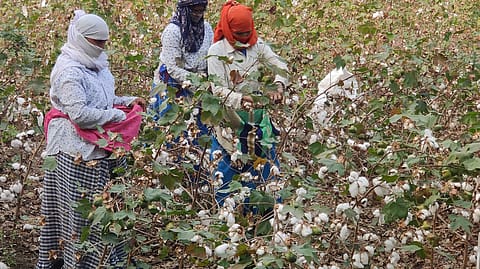Threads of change: Reweaving the fabric of India’s cotton sector
Various challenges are pushing up the cost of cotton cultivation, impacting yields and creating a perfect storm for cotton grower.

Climate change induced by global warming is exacerbating India’s cotton crisis, leading to increased incidences of pest attacks and disease outbreaks that are accelerating a decline in yields and productivity. India’s cotton production for the 2024-25 marketing year is projected to hit its lowest in over a decade and a half at just over 294 lakh bales. It marks the continuation of an over-decade-long fall in production from a peak of 398 lakh bales achieved in 2013-14.
The reasons for India’s steady drop in cotton production are manifold. However, they are largely rooted in climate change.
Climate change has disrupted weather patterns and altered temperatures. The changing weather and rising temperatures have created conditions in which pests, most notably cotton’s age-old nemesis, the pink bollworm, can thrive. It has also weakened the crop’s ability to resist such attacks.
These factors are pushing up the cost of cotton cultivation while depressing yields, creating a perfect storm that is sapping margins for cotton growers. They are driving farmers toward more lucrative alternatives, precipitating a fall in cotton acreage, even in top cotton-growing states like Gujarat, and in turn further fueling cotton’s decline.
Need of the hour: A holistic approach to pest management
With roughly 60 million people dependent on the cotton industry as a source of income, the sector is in dire need of attention. A holistic approach to crop protection that proves effective, incorporates technology, drastically reduces crop losses, and eventually brings farmers back into the cotton-growing fold could hold the key to reversing the cotton sector’s fortunes.
Integrated pest management could spearhead such an approach. Integrated pest management (IPM) offers a pragmatic, future-ready, and sustainable solution to address the pest-related challenges weighing on cotton production. The approach combines multiple pest-management practices such as biological, cultural, mechanical, and chemical methods to manage pests in an ecologically balanced and economically viable manner.
Recommended Stories
Unlike traditional methods that rely heavily on chemical pesticides, IPM takes a more calibrated approach, prioritising sustainable techniques like crop rotation and the introduction of natural predators, using chemicals only when necessary.
The benefits of IPM are proven. Rice farmers, for instance, who adopted the IPM approach saw yields surge as much as 40%. But IPM can only go so far. In today’s adverse agricultural landscape, technology is crucial to combating threats from pests. Artificial Intelligence and drones help farmers spot pest and disease outbreaks before they have had a chance to spread to most of the crop.
Drones, for example, can crisscross fields acting as farmers’ eyes in the sky that can speedily scan the cultivated area and precisely pick out any pest attacks or disease outbreaks.
Manually checking crops for outbreaks, on the other hand, is time and labour-intensive, and often detects the presence of pests only when it’s too late.
Drones can also be used to spray pesticides, making the process safer by reducing human exposure.
Government on a mission
To be sure, the government has recognised the need for a systemic overhaul of the cotton farming sector and has launched the National Cotton Productivity Mission (NCPM). The NCPM is a five-year mission that aims to reverse the decline in cotton production and is designed as a springboard for the entire cotton ecosystem, starting at the farm level but extending to encompass milling operations and even exports.
At the farm level, it seeks to empower farmers with technological support so they can adopt a modern, technologically-advanced, climate-resilient approach to cotton cultivation and crop protection. Further, it aims to give a fillip to the textile sector and eventually exports.
NCPM is aligned to India’s 5F vision of “farm to fibre, fibre to factory, factory to fashion, and fashion to foreign”.
If successful, the NCPM will strengthen India’s position as a global cotton superpower. The country currently accounts for just under a quarter of global production. However, it sits second behind China in the global cotton production stakes, with the latter leading despite having far less area under cotton cultivation.
To be successful, it needs the support of the private sector. Private sector participation in NCPM can be a game-changer for the cotton sector. It can lend NCPM crucial momentum that can take it from policy to reality.
To put it simply, India needs a cotton revival. A carefully thought-out approach to pest management, resilient to today’s challenges, combined with private sector participation in the ambitious NCPM, can help deliver it.
(The author is CEO, Crop Protection Business, Godrej Agrovet Ltd. Views are personal.)